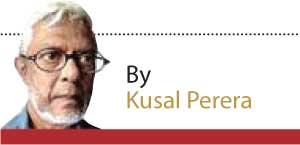Reply To:
Name - Reply Comment

Despite growing richer than ever before, China is increasingly haunted by the social challenge of inequality (Reuters)
Over a dozen and a half have apparently petitioned the Supreme Court against the “Colombo Port City (CPC) Commission” Bill, despite the serious time constraints the government created, by timing the tabling of the Bill for Thursday, April 8 with an extended long weekend ahead. All petitions claim the Bill allows the CPC Special Economic Zone (SEZ) to operate outside the Constitution and would make Sri Lanka look a “Chinese colony”.
created, by timing the tabling of the Bill for Thursday, April 8 with an extended long weekend ahead. All petitions claim the Bill allows the CPC Special Economic Zone (SEZ) to operate outside the Constitution and would make Sri Lanka look a “Chinese colony”.
While all such arguments raised need legal answers, none had questioned the concept of this SEZ in relation to “national development”. Creating an artificial islet neighbouring Colombo Port ignoring all opposition to environmental destruction was justified on the basis it would bring foreign direct investments (FDI) hitherto unavailable for “economic growth”.
Caught in a serious and a continuing financial crisis PM Wickremesinghe’s “Yahapalana” government had to go back on their loud election promise of 2015 to completely stop all Chinese projects. Wickremesinghe thus gave into Chinese conditions on the Hambantota harbour and accepted the CPC. That brought the urban middle class to accept the CPC and justify it. China thus came to be profiled as an economically powerful modern country developed on special economic and trade zones with mega FDIs.
How valid is this claim? Is China a truly developed, peaceful, democratic country with a “citizenry” alleviated from poverty? Is that China’s strength? These questions need insightful answers.
" China is facing intolerable levels of air, water and soil pollution. Over 300 cities with air quality monitoring facilities had failed to meet WHO standards"
China established its first SEZ in 1980 in Shenzhen after Deng Xiaoping took over China. Since then, Chinese authorities have established four (04) categories of special areas. They are (19) new State-level zones, (07) SEZs, (10) pilot FTZs and (15) coastal open cities. All of them located in Eastern and Southern coastal provinces.
A specialist on global trade and Chinese economic development Cécile Batisse in one of her observations notes, “The coast now plays a dominant role in economic activity. It concentrates most of the current pockets of development and the highest rates of growth. It has a high urbanisation rate, and it is there that most of the cities are located with over a million inhabitants.” (The Location of Manufacturing Industry and Special Imbalance/para 06) She also says, “…close to 90 per cent of foreign direct investment (FDI) is concentrated on the coastal provinces, in particular, the provinces of Guangdong, Fujian and Jiangsu and in Shanghai.”
National domestic production provides further evidence on poverty and its distribution. The per capita GDP of China in 2019 prior to COVID-19 was 70,892 Yuan. That same year Beijing recorded over double that national value with 164,220 Yuan. Shanghai too had a similar per capita GDP with 157,279 Yuan. Other industrialised coastal provinces like Jiangsu with 123,607, Zhejiang with 107,624, Fujian with 107,139, Guangdong 94,172, and Tianjin 90,371 Yuan, were all well above the national per capita GDP.
In contrast, interior provinces and the West show per capita GDP values far lower than the national value with Gansu 32,995, Heilongjiang with 36,183, Guangxi with 42,964, Jilin with 43,475 and Shanxi with 45,724 Yuan. As Batisse notes, “The prosperity of the coastal areas contrasts with the socio-economic and demographic blockages of the regions of the interior, as well as with the marginalisation of the west,…” (ibid).
"China never had an elected government by the People. The CCP plays both the role of People and the role of a “political State”
There is also urban poverty, with mass migration to major cities. By 1980 with Deng Xiaoping reforms, strict limitation on “one child per family” came to be relaxed and by 2000, new generations in rural provinces made land scarce. Relaxing of the 1950s “Hukou laws” on internal migration allowed migration from villages to cities. These youth, one set born after 1980 and the other after 1990 classified as “new generation youth” impacted on social values and personal needs. National Statistics Bureau of China notes the average migrant age of the 1980 group as 21.1 years while that of the 1990 group to be 17.4 years. The large migration of them to megacities created an excess labour market that supplied very cheap labour and also a large informal sector with uncertain employment and livelihoods.
These factors together contributed to urban poverty and a very large marginalised urban society. Added is the fact that urban crime had also increased with migrant new generation held partly responsible, according to researcher Xiaohu Chu.
Even towards 2017 as UNICEF notes, 53.6 per cent of the poor lived in few provinces in the West. Guizhou province had close to three million of the poor. Added to widespread poverty is the ruthless suppression of religious and ethnic minorities. Incidentally, most minorities live in poor and marginalised provinces. Despite denials by the Chinese authorities, of the 56 officially accepted minorities, the most inhumanly incarcerated ethnoreligious communities are Buddhist Tibetans and Muslim Uighurs in Xinjiang.
The first Tibetan kingdom since the introduction of “Mahayana” and “Wajrayana” Buddhism is recorded in the 06th Century. From 1950 for almost a decade Tibetans fought against Chinese military invasions and came under total Chinese military occupation in 1959. Since then, the fourth Dalai Lama who went into self-exile with over a thousand Tibetans claims a government in exile. Reports indicate over 1.2 million Tibetans massacred and killed over the decades. Chinese authorities are accused of deforesting around 40 per cent of Tibet’s forest cover and logged over 54 billion dollars worth of forest trees. Human rights reports claim around 6,000 Tibetan Buddhist ashrams destroyed with dominant majority Han Chinese settled, turning Tibetans into a minority under ruthless military occupation in their own land.
Considered the “dead centre” of Asia, Xinjiang is unique with eight countries bordering it and five being the Islamic States. Uighurs of Xinjian is a heavily concentrated population of 12.8 million of the Islamic faith. Initial conflicts in Xinjiang erupted over claims the Chinese authorities were promoting Han majority in Xinjiang. In 2009 Beijing declared conflicts in Xinjiang as “Islamic extremism” in justifying further crackdown of Uighur revolts. By now over a million Uighurs are incarcerated in about 380 torture camps the Chinese name as “Pre-education” camps. Women in these camps are sexually abused, collectively raped and subjected to forced sterilisation say reports based on inmates and escapees. Xinjiang being a major cotton cultivating province large numbers of these torture camps are now used as cotton factories using inmates as slaves, say human rights activists.
Environmental damage and devastations are another major tragedy. Utter neglect of the environment in its craze for accelerated industrialisation and quick profits, China is facing intolerable levels of air, water and soil pollution. Over 300 cities with air quality monitoring facilities had failed to meet WHO standards. Over 750,000 deaths annually are marked as due to respiratory complications. Forty per cent of Chinese rivers are considered seriously polluted and 20 per cent too toxic for even physical contact. Vast tracts of arable land are considered contaminated with high levels of toxic chemicals. Post Covid-19 plans include expansion of coal power by 250 gigawatts that would be greater than the existing US or Indian coal power capacity. Plans that include to add 22 “coal to chemical” power plants would emit an extra 175 million tonnes of CO2 to the environment (https://www.futuredirections.org.au/publication/china-continues-to-confront-steep-environmental-challenges/).
The trillion Yuan question thus is, how can a country with widespread poverty, horizontal and vertical social disparity, urban crime, environmental tragedies and ruthless suppression of ethnoreligious communities turn out as a rich and powerful country.
This has a forty-year plus history behind it. Mao Zedong’s “Red China” took a serious economic turn after Deng Xiaoping. His approach was quite different to Gorbachev’s “Perestroika” in Soviet Russia that was not adequate for economic growth and “Glasnost” too much party democracy too soon to digest.
Deng Xiaoping completely changed one of the two legacies of Mao’s Communism. “Communist economic legacy” was replaced by “free market” economy with FDIs encouraged in SEZs and FTZs. But Mao’s second legacy, the Chinese Communist Party (CCP) was used to have a firm grip over the economy. The CCP was turned into a more regimented and well-structured organisation and used far more efficiently for profits than any oligarchy in the Western capitalist economy.
China never had an elected government by the People. The CCP plays both the role of People and the role of a “political State”. The elite politburo that had evolved over decades from the time of “Comrade Mao” is more powerful than any government in any democracy. Provincially and locally, party branches play the role of political leadership and as “decentralised” administration, but strictly obedient to the “centre”. At local and factory level, CCP cadres play the role of civil society activists and as ideological “front runners”.
Publicly, close to 3,000 member (called Deputies) National People’s Congress (NPC) that meets twice a year is the supreme governing body. Politically it is the CCP politburo that appoints the NPC and governs the country. President of China has since 1982 become the powerful, almighty leader as General Secretary of the party as well.
The CCP is so structured into the State and into governance, President and the politburo decide all national policy, legislation and also issues directives to the military, while the President in addition holds unbridled power as General Secretary and leader of the CCP.
Under such power, all State agencies that came to be privatised post Deng Xiaoping still remains State property and is owned by the CCP hierarchy. To say it in plain language, all economic activities of these “private” companies including local and foreign business, investments and profits are decided by the CCP hierarchy.
This novel model of profiteering left space for the growth of “Dollar Billionaires” under the cautiously watchful eyes of the CCP leadership. “Hurun Researchers” who prepare “China’s Rich List” annually revealed when the NPC met in Beijing 2017 March the richest 209 Deputies was each worth 300 million US dollars. Their total wealth, equivalent to the annual GDPs of both Belgium and Sweden. What is more astonishing is, again as “Hurun” reveals, despite the COVID-19 devastation of the economy, Chinese businesses picked up so fast and big by August 2020, China boasted 2,398 US Dollar billionaires worth 04 trillion US dollars. The richest 20 of them are deputies of the NPC and attended the sessions in Beijing last March.
What needs to be stressed therefore is, China is not that of its 1.4 billion People. A free market economy with FDIs and China’s special zones for global trade has not developed China for its People. In post-Deng Xiaoping China power and wealth accumulated with the elite of the CCP and its pandered dollar billionaires. China, therefore, is a failed model of “socio-economic development”.